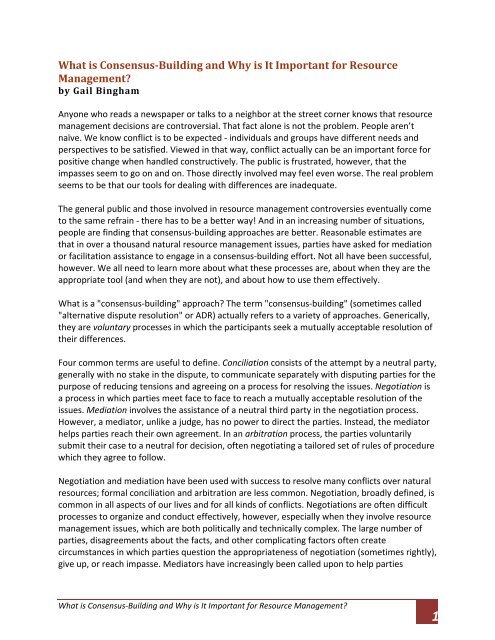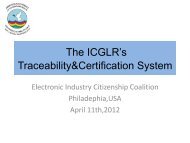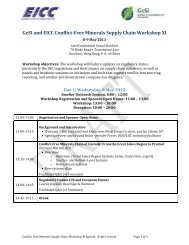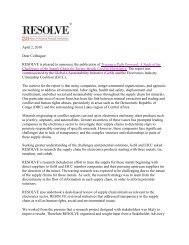What is Consensus-Building and Why is It Important for ... - Resolve
What is Consensus-Building and Why is It Important for ... - Resolve
What is Consensus-Building and Why is It Important for ... - Resolve
Create successful ePaper yourself
Turn your PDF publications into a flip-book with our unique Google optimized e-Paper software.
<strong>What</strong> <strong>is</strong> <strong>Consensus</strong>‐<strong>Building</strong> <strong>and</strong> <strong>Why</strong> <strong>is</strong> <strong>It</strong> <strong>Important</strong> <strong>for</strong> Resource<br />
Management?<br />
by Gail Bingham<br />
Anyone who reads a newspaper or talks to a neighbor at the street corner knows that resource<br />
management dec<strong>is</strong>ions are controversial. That fact alone <strong>is</strong> not the problem. People aren’t<br />
naïve. We know conflict <strong>is</strong> to be expected ‐ individuals <strong>and</strong> groups have different needs <strong>and</strong><br />
perspectives to be sat<strong>is</strong>fied. Viewed in that way, conflict actually can be an important <strong>for</strong>ce <strong>for</strong><br />
positive change when h<strong>and</strong>led constructively. The public <strong>is</strong> frustrated, however, that the<br />
impasses seem to go on <strong>and</strong> on. Those directly involved may feel even worse. The real problem<br />
seems to be that our tools <strong>for</strong> dealing with differences are inadequate.<br />
The general public <strong>and</strong> those involved in resource management controversies eventually come<br />
to the same refrain ‐ there has to be a better way! And in an increasing number of situations,<br />
people are finding that consensus‐building approaches are better. Reasonable estimates are<br />
that in over a thous<strong>and</strong> natural resource management <strong>is</strong>sues, parties have asked <strong>for</strong> mediation<br />
or facilitation ass<strong>is</strong>tance to engage in a consensus‐building ef<strong>for</strong>t. Not all have been successful,<br />
however. We all need to learn more about what these processes are, about when they are the<br />
appropriate tool (<strong>and</strong> when they are not), <strong>and</strong> about how to use them effectively.<br />
<strong>What</strong> <strong>is</strong> a "consensus‐building" approach? The term "consensus‐building" (sometimes called<br />
"alternative d<strong>is</strong>pute resolution" or ADR) actually refers to a variety of approaches. Generically,<br />
they are voluntary processes in which the participants seek a mutually acceptable resolution of<br />
their differences.<br />
Four common terms are useful to define. Conciliation cons<strong>is</strong>ts of the attempt by a neutral party,<br />
generally with no stake in the d<strong>is</strong>pute, to communicate separately with d<strong>is</strong>puting parties <strong>for</strong> the<br />
purpose of reducing tensions <strong>and</strong> agreeing on a process <strong>for</strong> resolving the <strong>is</strong>sues. Negotiation <strong>is</strong><br />
a process in which parties meet face to face to reach a mutually acceptable resolution of the<br />
<strong>is</strong>sues. Mediation involves the ass<strong>is</strong>tance of a neutral third party in the negotiation process.<br />
However, a mediator, unlike a judge, has no power to direct the parties. Instead, the mediator<br />
helps parties reach their own agreement. In an arbitration process, the parties voluntarily<br />
submit their case to a neutral <strong>for</strong> dec<strong>is</strong>ion, often negotiating a tailored set of rules of procedure<br />
which they agree to follow.<br />
Negotiation <strong>and</strong> mediation have been used with success to resolve many conflicts over natural<br />
resources; <strong>for</strong>mal conciliation <strong>and</strong> arbitration are less common. Negotiation, broadly defined, <strong>is</strong><br />
common in all aspects of our lives <strong>and</strong> <strong>for</strong> all kinds of conflicts. Negotiations are often difficult<br />
processes to organize <strong>and</strong> conduct effectively, however, especially when they involve resource<br />
management <strong>is</strong>sues, which are both politically <strong>and</strong> technically complex. The large number of<br />
parties, d<strong>is</strong>agreements about the facts, <strong>and</strong> other complicating factors often create<br />
circumstances in which parties question the appropriateness of negotiation (sometimes rightly),<br />
give up, or reach impasse. Mediators have increasingly been called upon to help parties<br />
<strong>What</strong> <strong>is</strong> <strong>Consensus</strong>‐<strong>Building</strong> <strong>and</strong> <strong>Why</strong> <strong>is</strong> <strong>It</strong> <strong>Important</strong> <strong>for</strong> Resource Management?<br />
1
convene negotiations, to prevent impasse during the negotiations, or to ass<strong>is</strong>t parties to<br />
continue when their d<strong>is</strong>cussions have broken down.<br />
In mediated negotiations, the mediator does not make a dec<strong>is</strong>ion about who <strong>is</strong> right or wrong<br />
or what the best outcome should be. Instead, a mediator helps those involved hold<br />
constructive d<strong>is</strong>cussions by calling meetings, establ<strong>is</strong>hing a framework <strong>for</strong> the negotiation<br />
within which all parties agree to participate, <strong>and</strong> facilitating communication in <strong>and</strong> between<br />
meetings. Mediators often ass<strong>is</strong>t the parties in identifying where they may be able to agree or<br />
ways in which they can address their d<strong>is</strong>agreements, <strong>for</strong> example, through joint fact‐finding.<br />
They also ass<strong>is</strong>t by drafting, facilitating d<strong>is</strong>cussion of, <strong>and</strong> refining agreement language that<br />
then <strong>is</strong> reviewed <strong>for</strong> implementability by all parties. Professional mediators hold as a matter of<br />
ethics the view that mediators should have no direct interest in the outcome of the d<strong>is</strong>pute, i.e.<br />
that they should be neutral. Frequently, however, a party with a stake in achieving a solution or<br />
with power or resources to ass<strong>is</strong>t the parties, who <strong>is</strong> not a central protagon<strong>is</strong>t, may take on<br />
mediation functions.<br />
A key advantage to both mediation <strong>and</strong> negotiation <strong>is</strong> that the parties have significant control<br />
over the end result. Dec<strong>is</strong>ion‐making power stays in the parties' h<strong>and</strong>s <strong>and</strong> <strong>is</strong> not passed on to a<br />
judge or arbitrator.<br />
Mediation can take various <strong>for</strong>ms, depending on the dec<strong>is</strong>ion to be made <strong>and</strong> the stage of the<br />
d<strong>is</strong>pute. Some of these variations have become sufficiently <strong>for</strong>malized to be given different<br />
names. These include negotiated rulemaking, policy dialogues, joint fact‐finding, facilitation<br />
(generally applied to public meetings or in<strong>for</strong>mal workshops), <strong>and</strong> partnering (generally applied<br />
to construction contracts).<br />
In the resources management arena, consensus‐building processes have been implemented in<br />
numerous situations, including endangered species, watershed management councils, <strong>for</strong>est<br />
plan appeals, mining <strong>is</strong>sues, grazing, estuarine planning, commercial f<strong>is</strong>heries, <strong>and</strong> many more.<br />
The case studies that follow <strong>for</strong> th<strong>is</strong> special session are good illustrations.<br />
Elements of Effective <strong>Consensus</strong> Processes<br />
Most d<strong>is</strong>pute resolution literature urges that specific d<strong>is</strong>putes be managed in such a way as to<br />
allow all sides to express their views, preferably directly to one another. (Traditional public<br />
hearing or notice <strong>and</strong> comment procedures used by government agencies do give the public a<br />
voice, but do so in ways that actually create incentives <strong>for</strong> polarization.) Underlying conflicts<br />
should not be avoided, because without underst<strong>and</strong>ing <strong>and</strong> accepting their differences people<br />
cannot jointly solve problems. Th<strong>is</strong> <strong>is</strong> not to say, however, that all modes of expressing conflicts<br />
are constructive. D<strong>is</strong>pute resolution methods focus on structuring incentives to deal with<br />
differences <strong>and</strong> on improved communication between parties in order to better identify<br />
options that sat<strong>is</strong>fy these different interests <strong>and</strong> values.<br />
To think well about improving effectiveness, it <strong>is</strong> important to have a picture of one’s target.<br />
When people refer to "success," they mean several things. Generally, these factors fall into<br />
<strong>What</strong> <strong>is</strong> <strong>Consensus</strong>‐<strong>Building</strong> <strong>and</strong> <strong>Why</strong> <strong>is</strong> <strong>It</strong> <strong>Important</strong> <strong>for</strong> Resource Management?<br />
2
three categories ‐ substance, process, <strong>and</strong> relationships. Examples of common measures of<br />
success mentioned by parties to d<strong>is</strong>putes include:<br />
substance<br />
reaching agreements,<br />
reaching an agreement that sat<strong>is</strong>fies their interests or solves real problems,<br />
reaching an agreement better than otherw<strong>is</strong>e could have been achieved,<br />
reaching agreements that are implemented,<br />
process<br />
fair,<br />
all affected parties represented,<br />
no undue delay,<br />
allows adequate consultation with constituencies,<br />
not overly costly in time or money,<br />
cons<strong>is</strong>tent with applicable procedures <strong>and</strong> laws (e.g. open meeting laws),<br />
does not set precedent <strong>for</strong> other parties not at the table, <strong>and</strong><br />
encourages the exchange of accurate <strong>and</strong> complete in<strong>for</strong>mation.<br />
relations<br />
civil,<br />
provides mutual recognition <strong>and</strong> respect, <strong>and</strong><br />
improved capacity to solve problems together in the future.<br />
Implementation of agreements that solve real problems <strong>for</strong> those involved <strong>is</strong> probably the most<br />
important measure of success, but factors such as improved relationships among the parties or<br />
development of an improved in<strong>for</strong>mation base or array of options <strong>for</strong> later consideration can<br />
also be valued outcomes of consensus‐building, as some (if not complete) progress toward a<br />
resolution.<br />
Considerable research has gone into how to increase the likelihood of success in negotiations or<br />
consensus‐building ef<strong>for</strong>ts. People commonly approach negotiation with the idea that each side<br />
takes a position, trades concessions, <strong>and</strong> agrees (sometimes) at a point in the middle. Th<strong>is</strong><br />
certainly <strong>is</strong> an accurate description of how many people negotiate (<strong>and</strong> one cannot d<strong>is</strong>count<br />
these dynamics in dealing with certain <strong>is</strong>sues), however, the d<strong>is</strong>advantages of th<strong>is</strong> kind of<br />
"horsetrading" are that it becomes a battle of wills <strong>and</strong> creates bad feelings, it takes longer, <strong>and</strong><br />
agreements reached often are less sat<strong>is</strong>factory because of the lack of focus on the parties' real<br />
needs <strong>and</strong> concerns.<br />
The principle of focusing on interests not positions underlies most d<strong>is</strong>pute resolution theory<br />
<strong>and</strong> practice. One way to underst<strong>and</strong> th<strong>is</strong> concept <strong>is</strong> to underst<strong>and</strong> <strong>is</strong>sues as the questions to be<br />
answered, a position as one party's answer to these questions, <strong>and</strong> their interests as the<br />
reasons they hold that position. First articulated in the book Getting To Yes by Roger F<strong>is</strong>her <strong>and</strong><br />
William Ury, these authors champion the view that the essence of successful negotiations <strong>is</strong> to<br />
avoid bargaining over positions. They outline some very helpful principles <strong>for</strong> how to do th<strong>is</strong><br />
effectively, all of which shift the dynamics to more creative problem solving:<br />
<strong>What</strong> <strong>is</strong> <strong>Consensus</strong>‐<strong>Building</strong> <strong>and</strong> <strong>Why</strong> <strong>is</strong> <strong>It</strong> <strong>Important</strong> <strong>for</strong> Resource Management?<br />
3
D<strong>is</strong>cuss <strong>and</strong> address interests. <strong>It</strong> <strong>is</strong> critical to ask why one side <strong>is</strong> asserting a particular<br />
position on the <strong>is</strong>sues, to underst<strong>and</strong> what they really need to achieve. Interests can be met in<br />
many ways; positions are much more rigid.<br />
Underst<strong>and</strong> the role of interpersonal dynamics in negotiations <strong>and</strong> help people<br />
move on. F<strong>is</strong>her <strong>and</strong> Ury call th<strong>is</strong> "separating the people from the problem," meaning that it <strong>is</strong><br />
important to underst<strong>and</strong> the role that emotions play in a d<strong>is</strong>pute but not to allow those<br />
emotions to block one from addressing each problem on its merits. Personal prejudices <strong>and</strong><br />
prior h<strong>is</strong>tory need to be understood ‐ they may constitute problems people want to solve ‐ but<br />
people should not let themselves be so motivated by bad interpersonal feelings that th<strong>is</strong><br />
becomes a barrier to self‐interest.<br />
Generate a wide range of options, minimizing judgments at first. People are less<br />
likely to hit an impasse when many options are being evaluated. Somehow, it creates at least a<br />
partial perception of everyone being on the same "side of the table," evaluating the pros <strong>and</strong><br />
cons of options more collaboratively. A common example of th<strong>is</strong> <strong>is</strong> the technique of<br />
brainstorming.<br />
Agree on criteria by which to judge options <strong>for</strong> resolution. <strong>It</strong> may be easier at the<br />
beginning of a process to l<strong>is</strong>t the general requirements that a potential agreement must sat<strong>is</strong>fy<br />
than to develop the details of specific options. Such criteria are also very helpful in maintaining<br />
the sense of common endeavor in evaluating options as they emerge, <strong>for</strong> two reasons. First, the<br />
legitimacy of each side's needs <strong>is</strong> at least tacitly accepted ‐ these criteria are often surrogates<br />
<strong>for</strong> parties' underlying interests. In using these criteria together, parties find themselves dealing<br />
with how to solve others' problems, <strong>and</strong> experience their own problems being treated as<br />
relevant by the others. Second, where parties agree on objective criteria, it can help break<br />
impasses.<br />
Although these are good principles on which to ground constructive dialogue, not every<br />
negotiation <strong>is</strong> entirely interest based ‐ eventually a pie can't be made any larger <strong>and</strong> parties are<br />
faced with deciding who will get what. A certain amount of competition <strong>is</strong> inevitable in dividing<br />
up a finite resource (or fixed pie). Nor can the effect that political power plays in negotiation<br />
dynamics be ignored. But these principles do allow participants in a consensus‐building ef<strong>for</strong>t to<br />
maximize the creativity needed to create more "joint gains" ‐ an essential ingredient in sound<br />
resource management dec<strong>is</strong>ions. Several contributors to current negotiation theory (e.g.,<br />
Raiffa, Lax, Lewicki) focus on the "tension between cooperation <strong>and</strong> competition,"<br />
d<strong>is</strong>tingu<strong>is</strong>hing between "creating value" <strong>and</strong> "claiming value." While urging parties to seek ways<br />
to exp<strong>and</strong> the pie, (i.e., to invent solutions that achieve joint gains, they also caution parties<br />
that if one side cooperates ‐ <strong>for</strong> example by sharing in<strong>for</strong>mation ‐ <strong>and</strong> others compete, the<br />
more competitive often win.<br />
There are additional reasons why resource management <strong>is</strong>sues are difficult to resolve.<br />
Convening a consensus‐building process will not make these challenges go away magically.<br />
<strong>What</strong> <strong>is</strong> <strong>Consensus</strong>‐<strong>Building</strong> <strong>and</strong> <strong>Why</strong> <strong>is</strong> <strong>It</strong> <strong>Important</strong> <strong>for</strong> Resource Management?<br />
4
Rather, <strong>for</strong> a consensus process to be successful, it must be designed with these challenges in<br />
mind:<br />
Controversial natural resources <strong>is</strong>sues often are made more difficult to resolve by intraorganizational<br />
<strong>and</strong> institutional complexities.<br />
Parties’ incentives to address one another’s needs may be unclear.<br />
Forests, wetl<strong>and</strong>s, wildlife populations are finite, increasing the potential <strong>for</strong><br />
competition among users.<br />
Technical <strong>and</strong> scientific uncertainties can complicate negotiations.<br />
D<strong>is</strong>putes over natural resources generally involve public <strong>is</strong>sues, not private matters<br />
alone; laws, press, <strong>and</strong> governmental institutions all play a significant role.<br />
An important character<strong>is</strong>tic of consensus‐building processes, as they have been implemented<br />
over the past 20 years in the resource management arena, <strong>is</strong> that they are flexible. Individual<br />
processes can <strong>and</strong> should be tailored to each d<strong>is</strong>pute after an analys<strong>is</strong> of the particular<br />
opportunities <strong>and</strong> barriers involved. Controversies develop at different stages in the "life‐cycle"<br />
of a controversy, with different degrees of polarization, <strong>and</strong> with in<strong>for</strong>mation <strong>and</strong> options<br />
elaborated at varying degrees of detail. Legal constraints on the process <strong>and</strong> alternatives to<br />
settlement available to the parties also vary case by case <strong>and</strong> at different stages of the same<br />
matter.<br />
Institutional Dynamics<br />
Resource management conflicts are more often between organizations or groups than between<br />
individuals. Thus, the individuals at the table must get proposals ratified by others who are not<br />
participating directly. Because each entity has its own internal dec<strong>is</strong>ion‐making process,<br />
negotiators (<strong>and</strong> neutrals) need to know the degree to which each representative can speak <strong>for</strong><br />
h<strong>is</strong> or her constituency <strong>and</strong> the freedom each has to make proposals <strong>and</strong> to commit to an<br />
agreement. Negotiators also must keep their constituencies in<strong>for</strong>med about progress <strong>and</strong><br />
problems between negotiation sessions to increase the likelihood that agreements, if reached,<br />
will be ratified.<br />
Complex or Changing Incentives<br />
In contrast to more traditional admin<strong>is</strong>trative or judicial proceedings, few, if any, establ<strong>is</strong>hed<br />
procedures are available to structure routine applications of consensus‐building processes to<br />
resource management <strong>is</strong>sues. (The Admin<strong>is</strong>trative D<strong>is</strong>pute Resolution Act, at the federal level,<br />
does provide cons<strong>is</strong>tent definitions, <strong>and</strong> a few selected statutes direct the <strong>for</strong>mation of<br />
consensus processes <strong>for</strong> specific <strong>is</strong>sues.) Each party, with different strengths in different<br />
<strong>for</strong>ums, will have different perceptions about the relative advantages of negotiating. Thus,<br />
parties are as likely to approach a negotiation with different assumptions on how to structure<br />
the negotiating relationship as they are to have different views on the <strong>is</strong>sues.<br />
A st<strong>and</strong>ard element of good mediation practice in resolving controversial environmental <strong>is</strong>sues<br />
<strong>is</strong> to conduct a feasibility assessment with the potential parties to a negotiation. All parties<br />
should feel they have something to gain, <strong>and</strong> no one should feel the negotiation process would<br />
harm their current st<strong>and</strong>ing on the resolution of the <strong>is</strong>sues. Thus, it becomes a goal of the<br />
<strong>What</strong> <strong>is</strong> <strong>Consensus</strong>‐<strong>Building</strong> <strong>and</strong> <strong>Why</strong> <strong>is</strong> <strong>It</strong> <strong>Important</strong> <strong>for</strong> Resource Management?<br />
5
assessment to help parties assess how potential negotiation results would compare with their<br />
alternatives. Often, how the negotiation process <strong>is</strong> organized will directly affect the potential of<br />
the process to sat<strong>is</strong>fy parties' interests. A key product of any feasibility assessment will be<br />
general agreement (often mediated) among the parties as to who will participate <strong>and</strong> in what<br />
way, the scope of <strong>is</strong>sues, any deadlines, frequency of meetings, in<strong>for</strong>mation needed to make<br />
sound dec<strong>is</strong>ions, who the mediator will be (if any), <strong>and</strong> other ground rules.<br />
Multiple Parties/Issues<br />
Because natural resources, although renewable, are finite <strong>and</strong> ex<strong>is</strong>t in specific places, claims of<br />
rights to use the "same" locations <strong>for</strong> different uses are made by multiple units <strong>and</strong> levels of<br />
government <strong>and</strong> diverse private interests. Th<strong>is</strong> generally means that resource management<br />
d<strong>is</strong>putes involve many parties <strong>and</strong> many <strong>is</strong>sues, making organizing any negotiation process<br />
more difficult. Sometimes coalitions can be <strong>for</strong>med, where several parties can be represented<br />
by one negotiator. Concerns have been ra<strong>is</strong>ed about limits to participation being imposed in<br />
some consensus‐processes, where national interests may be at stake over what others might<br />
view as local resources. Th<strong>is</strong> <strong>is</strong>sue of scale, who has a right to participate, <strong>and</strong> the inability due<br />
to lack of resources of some groups to participate in many different processes needs<br />
exploration.<br />
Complex Scientific <strong>and</strong> Technical Issues<br />
Sound scientific <strong>and</strong> technical in<strong>for</strong>mation <strong>is</strong> essential <strong>for</strong> creating solutions that work.<br />
However, parties to natural resources <strong>is</strong>sues are confronted with large volumes of in<strong>for</strong>mation,<br />
requiring a wide variety of expert<strong>is</strong>e, <strong>and</strong> subject to honest differences of interpretation.<br />
Furthermore, gaps <strong>and</strong> uncertainties in the available in<strong>for</strong>mation base are inevitable as<br />
scientific underst<strong>and</strong>ing continues to grow.<br />
Models can be developed to help deal with scientific uncertainties, but they themselves can be<br />
sources of d<strong>is</strong>pute between the model builders or sources of confusion in negotiations where<br />
parties have unequal technical resources. Joint fact‐finding processes, in which parties agree on<br />
the design of a model or study in advance, show considerable prom<strong>is</strong>e. Similarly, technical<br />
committees or in<strong>for</strong>mation sharing workshops have been used constructively to supplement<br />
policy negotiations.<br />
Public/Political Dimension<br />
Another character<strong>is</strong>tic complicating resource management conflicts <strong>is</strong> that the <strong>is</strong>sues in d<strong>is</strong>pute<br />
involve public matters that may need to be resolved in public <strong>for</strong>ums. Negotiators need to deal<br />
with the press <strong>and</strong> open meeting laws sensitively, <strong>and</strong> arrive at outcomes that can withst<strong>and</strong><br />
public scrutiny <strong>and</strong> comment. Carefully designed, consensus‐building processes can maximize<br />
the flexibility within public institutions while holding negotiated solutions to the same legal <strong>and</strong><br />
regulatory st<strong>and</strong>ards to which any dec<strong>is</strong>ion would be subject.<br />
Conclusion<br />
Experience suggests that the following prerequ<strong>is</strong>ites <strong>and</strong> strategies will increase the likelihood<br />
that consensus‐building can be successful in complex, resource management <strong>is</strong>sues:<br />
all can gain something they value in the process;<br />
<strong>What</strong> <strong>is</strong> <strong>Consensus</strong>‐<strong>Building</strong> <strong>and</strong> <strong>Why</strong> <strong>is</strong> <strong>It</strong> <strong>Important</strong> <strong>for</strong> Resource Management?<br />
6
all important players are willing to participate;<br />
participants agree on the process structure <strong>and</strong> goal, including a definition of the<br />
problem;<br />
no one will be asked to comprom<strong>is</strong>e a basic value;<br />
participants share in<strong>for</strong>mation with each other or seek in<strong>for</strong>mation together early in the<br />
process;<br />
interests are identified <strong>and</strong> communicated;<br />
multiple options are encouraged, <strong>and</strong> parties d<strong>is</strong>cuss criteria by which to evaluate them;<br />
the time necessary <strong>for</strong> negotiation <strong>is</strong> available;<br />
the <strong>is</strong>sue <strong>is</strong> "ripe" <strong>for</strong> resolution, <strong>and</strong> there <strong>is</strong> a deadline or urgency <strong>for</strong> dec<strong>is</strong>ion;<br />
the process <strong>is</strong> transparent <strong>and</strong> communication with broader interests occurs<br />
throughout; <strong>and</strong><br />
all parties have authority to make commitments<br />
References<br />
Bingham, Gail. Resolving Environmental D<strong>is</strong>putes: A Decade of Experience. The Conservation<br />
Foundation. 1986.<br />
Bingham, Gail; Aaron Wolf, <strong>and</strong> Tim Wohlgenant. Resolving Water D<strong>is</strong>putes: Conflict <strong>and</strong><br />
Cooperation in the United States,the Near East, <strong>and</strong> Asia. U.S. Agency <strong>for</strong> International<br />
Development, Irrigation Support Project <strong>for</strong> Asia <strong>and</strong> the Near East. 1994.<br />
F<strong>is</strong>her, Roger, William Ury, <strong>and</strong> Bruce Patton. Getting to Yes. Penguin Books, Second Edition.<br />
1991.<br />
Mccloskey, Michael. "The skeptic: Collaboration has its limits." High Country News. May 13,<br />
1996.<br />
Moore, Chr<strong>is</strong>topher W. The Mediation Process: Practical Strategies <strong>for</strong> Resolving Conflict.<br />
Jossey‐Bass Publ<strong>is</strong>hers. 1987.<br />
Raiffa, Howard. The Art <strong>and</strong> Science of Negotiation. Belknap Press. 1982.<br />
Singer, Linda R. Settling D<strong>is</strong>putes: Conflict Resolution in Business, Families, <strong>and</strong> the Legal<br />
System. Westview Press. 1990.<br />
Ury, William, Jeanne Brett, <strong>and</strong> Stephen Goldberg. Getting D<strong>is</strong>putes <strong>Resolve</strong>d: Designing<br />
Systems to Cut the Costs of Conflict. Jossey‐Bass Publ<strong>is</strong>hers. 1988.<br />
1255 23rd Street, NW, Suite 275<br />
Washington, DC 20037<br />
www.resolv.org | (202)944‐2300














